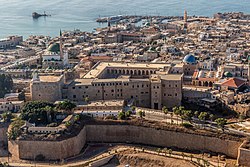Hospitaller commandery of Saint-Jean-d'Acre
| Hospitaller commandery of Saint-Jean-d'Acre | |
|---|---|
| Saint-Jean d'Acre in Kingdom of Jerusalem, Israel | |
 Actual view of the commandery | |
 Flag of the Order of St. John | |
| Coordinates | 32°55′24.49″N 35°04′09.61″E / 32.9234694°N 35.0693361°E |
| Type | Commandery |
| Site information | |
| Owner | Knights Hospitaller |
| Controlled by | Knights Hospitaller |
| Site history | |
| Built | 12th century 13th century |
| Built by | Knights Hospitaller |
| In use | 1149-1291 |
| Materials | Sandstone |
| Battles/wars | Siege of Saint-Jean-d'Acre (1189-1191) Siege of Saint-Jean-d'Acre (1291) |
| Events | Crusades |
The Hospitaller commandery of Saint-Jean-d'Acre is a monumental complex founded by the Order of St. John of Jerusalem, also known as the Knights Hospitallers. It is located in the city of Saint-Jean-d'Acre (now Acre in Israel). In the 13th century, the commandery became the headquarters of the Order until the fall of the city in 1291.[1]
History
The first years
From the first years of the establishment of the Crusaders in the city, the Hospitallers received donated properties. In 1110, King Baldwin granted the Knights Hospitaller permission to keep the constructions located north of the Sainte-Croix church. In the years 1130, the buildings were damaged during works near the church and the Hospitallers decided to move near the 12th century north wall of the city. This is the actual place of the commandery.
In 1149, the first testimony of the commandery is in a document concerning the construction of the Saint-Jean church. In 1169, a pilgrim described the commandery of the Hospitallers of Acre as a very impressive fortified building.
Relocation of headquarters
After the defeat of Hattin in 1187, Saladin took the city. In 1191, during the third Crusade, the Frankish reconquered Acre after its siege. The Hospitallers moved back in their buildings. Jerusalem is no longer in the hands of the crusaders. And so the commandery becomes the new headquarters of the order. A new construction campaign took place between the end of 12th century and 13th century with new wings and additional floors.
Architecture
This section is empty. You can help by adding to it. (April 2020) |
The inner courtyard
The courtyard has an area of 1200 m2 and is surrounded by a series of arcades. On the east side, a staircase leads to the upper parts. A well with a depth of 4.5 m is located near the north side and two shallow pools are next to this well. On the south side a pool with a depth of 1.5 m and another well were built.
The north wing
This wing was built along the north wall. There are ten vaulted rooms ten meters high built during the Frankish era. The exterior wall is massive with a thickness of 3.5 m. Later to the west, two new rooms will complete this building. In the south wall, there are windows that overlook a narrow passage and the wall of the pillar room. The entrance of the building is in the south side wall.
The west wing
The east wing
The south wing
The main hall of the south wing is housing the refectory, sometimes falsely presented as the Crypt of the Knights of St John.
In the northeast and southeast corners of the refectory, excavators discovered two corbels bearing the chief feature of the coat of arms of the kings of France, the fleur-de-lys.[2] Louis VII has chosen this symbol during the Second Crusade (1147–1149).[3] The oldest depictions surviving in Europe go back to 1180, so the one from the Acre refectory could be associated with Louis VII's presence in Acre in 1148. [2]
The Saint-Jean church
See also
Gallery
-
The courtyard.
-
The refectory.
-
Console with a sculpted fleur-de-lis.
-
Gravestone of Pierre de Vieille-Brioude.
-
The crypt.
-
The latrines.
-
Tunnel under the commandery.
-
Hospitaller's sugar mould and molasses pot.
References
- ^ Stern, Eliezer (2006). "La commanderie de l'Ordre des Hospitaliers à Acre". Bulletin Monumental. 164 (1): 53–60. doi:10.3406/bulmo.2006.1318.
- ^ a b Goldmann, Ze'ev (1977). "Die Bauten des Johanniterordens in Akkon". In Adam Wienand (chief ed.); Carl Wolfgang Graf von Ballestrem; Christoph Freiherr von Imhoff (eds.). Der Johanniter-Orden – Der Malteser-Orden: Der ritterliche Orden des heiligen Johannes vom Spital zu Jerusalem – Seine Aufgaben, seine Geschichte (in German). Cologne: Wienand Verlag. pp. 108–115 (109). ISBN 9783879090761. Page number here as indicated in the footnotes. For German article about the author see here
- ^ Goldmann, Ze'ev (1967). "The Hospice of the Knights of St. John in Akko". Archeological Discoveries in the Holy Land. Thomas Y. Crowell Co., New York for the Archaeological Institute of America. pp. 199–206 (202).








